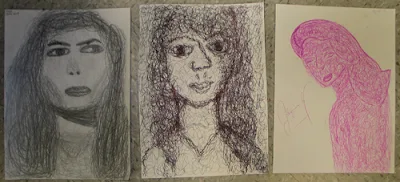Student samples of scribble portraits above.
Title: A Scribble Portrait Drawing Exercise
Topic: gesture drawing exercises, working with ballpoint pens
Goals:
- Students will demonstrate a gestural technique called scribble drawing with paper and a ballpoint pen.
- Students will draw a portrait of one of their peers from life.
- Students will identify negative and positive space, texture, and a range of values in their drawing through the representation of these concepts in their drawing.
GLEs:
STRAND II: Elements and Principles (EP)
1. Select and use elements of art for their effect in communicating ideas through artwork
D. Texture: High School Level I
· Identify and use real, invented and simulated textures
STRAND II: Elements and Principles (EP)
1. Select and use elements of art for their effect in communicating ideas through artwork
F. Value: High School Level I
· Identify and use a range of values to create the illusion of simple forms (including highlights and cast shadows)
STRAND II: Elements and Principles (EP)
1. Select and use elements of art for their effect in communicating ideas through artwork
G. Space: High School Level I
· Identify and use positive and negative space in two-dimensional work
· Identify and use perspective techniques to create the illusion of space (one-point linear perspective, overlapping, and change of size, detail, placement, value contrast)
STRAND II: Elements and Principles (EP)
2. Select and use principles of art for their effect in communicating ideas through artwork
D. Rhythm/Repetition: High School Level I
· Identify and use elements to create regular rhythm
STRAND II: Elements and Principles (EP)
2. Select and use principles of art for their effect in communicating ideas through artwork
F. Proportion: High School Level I
· Identify and use realistic facial proportions
Grade: 9th – 12th
Length of Class Period: 55 minutes
Frequency of Class Period: five days a week
Time Needed: one class period
Facility & Equipment Requirements:
- One computer lap top
- Room with good lighting
- Large tables, approximately ten, each seating four students
- Two sinks
- Dry erase board
- Drying racks
- Cabinets for storage
- Projector for viewing computer video, CDs and DVDs
Resources Needed Per Student:
1. Power Point Introducing Scribble Drawing2. "Art school how to paint and draw" by Hazel Harrison
Materials Per Student:
· Black or blue ball point pen
· One sheet of white drawing paper
Vocabulary/Terminology:
· “Scribble Drawing - Students can learn to build up tones and forms in a looser, less-organized way, by scribbling with the pen. This is a harder technique to handle than cross-hatching because it is random. You must learn to let the pen do the work for you. The technique of scribble drawing was first used by Picasso, when in revolt against traditional methods, and can give a dynamic quality to a drawing.” Harrison
Motivation- Looking and Talking Activity: Approximately ten minutes of gesture drawing will be practiced at the beginning of class then students will view a brief introduction to scribble drawing as this alternative gesture drawing activity is explained.
Step-by-Step Studio Activity Specifics:
- Students will be handed newsprint at the beginning of the class period to practice gestural drawing. They have been doing this activity for the last two days.
- Students will view and discuss with the teacher the concept of scribble drawing.
- Students will then be provided with nice drawing paper and ballpoint pens.
- Students will then be asked to practice the new gestural drawing technique while observing a partner directly in front of them.
- Students will draw using the scribble technique for approximately 45 minutes.
- Students will return their drawing pens and hand in their portrait exercises at the front of the classroom.
- Students will be dismissed by the bell.
Health & Safety Concerns: There are no health and safety concerns for this project.
Special Needs Adaptations:
Modifications for the hard-of-hearing or deaf student:
- Student will be seated closer to instructor so they will be better equipped to hear instructions or read lips
- Student will be provided with written instructions so that they read about the discussions and demonstrations
- The instructor may use a amplification devise provided by the school or student’s parents
Cleanup Time & Strategy: Students will be instructed to put away art materials neatly in their containers, clean off their tables, and recycle their trash two minutes prior to dismissal.
Assessment: The assessment of this assignment is informal because it is an exercise used to develop student’s skills in gestural concepts. The cooperating teacher may choose to assign points to the exercise after completion.
All images and text copyrighted 2011, Grimm




No comments:
Post a Comment